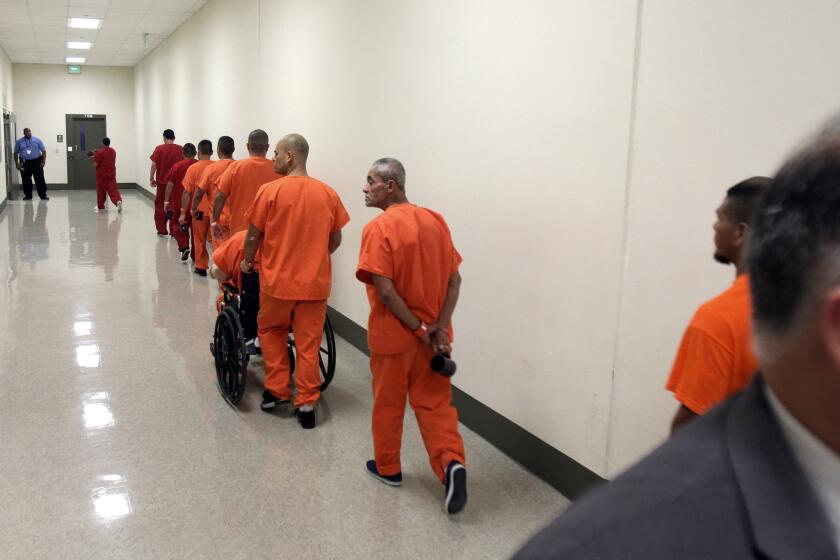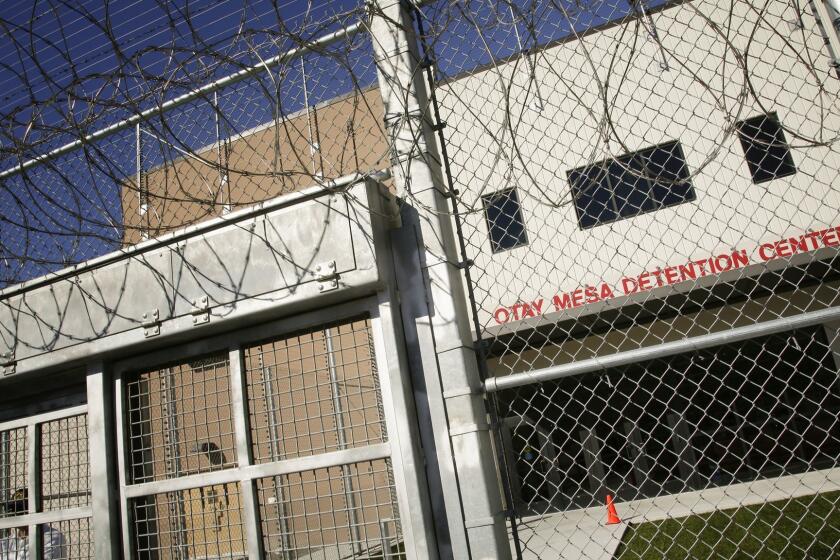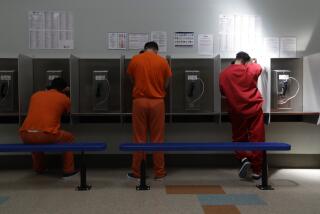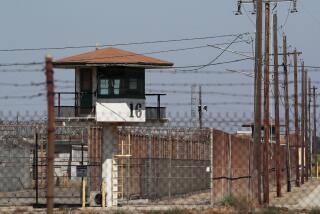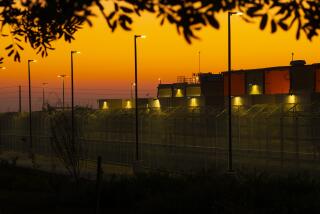Federal detainees say they aren’t isolated while awaiting coronavirus test results
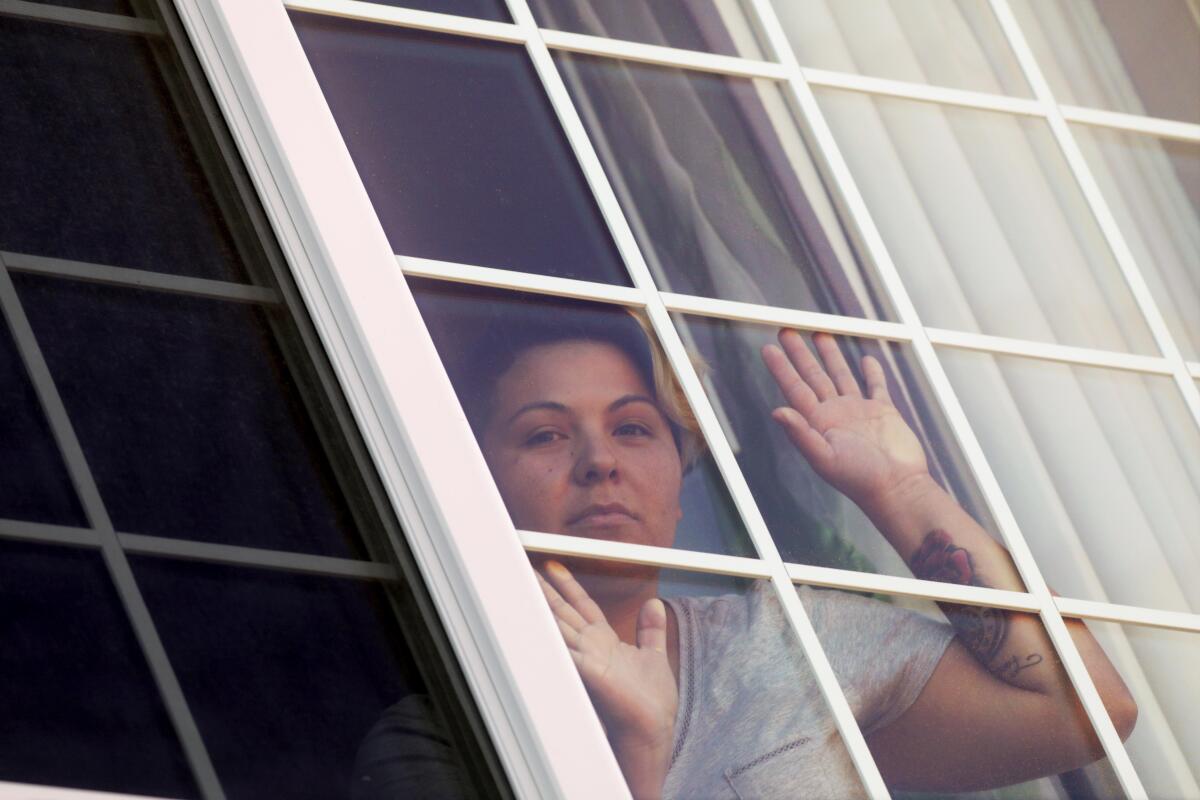
- Share via
Maria Garcia had a cough and body aches. When she talked, she ran out of breath.
Garcia, who has been detained by federal immigration authorities at Otay Mesa Detention Center in San Diego since October, was tested for the coronavirus about two weeks ago.
While she waited for the result to come back, she remained in her regular housing unit.
Days later, officials told her and several other women in her unit to gather their belongings. Once they got to the new unit, one woman asked why they had been moved.
“Did we test positive?” Garcia said the woman asked the guards.
They had.
The agency is stepping up horseback patrols along the coast to deter smuggling and prevent the entry of people infected with the coronavirus.
Detainees, inmates and attorneys say that people in custody at Otay Mesa who are suspected of having COVID-19 are not quarantined and instead remain in the general population until they officially test positive for the coronavirus, leaving the potential for other detainees to become infected in the meantime.
The allegation is one of several issues raised about coronavirus testing there, and the latest in a series of complaints from people held at the facility about the care they’re receiving during the pandemic.
The morning after the women were moved, someone came to check their temperatures, Garcia said. A few times per shift, someone looked through a window at them to check on them.
“No one is worried about us,” Garcia said. “We don’t know anything. They just come by outside, look at us and go.”
Otay Mesa, which is run by the private prison company CoreCivic, has become a coronavirus hot spot for San Diego County as well as for immigration detainees nationwide.
CoreCivic has maintained that it is following guidelines set forth by the Centers for Disease Control and Prevention and by the two federal agencies — Immigration and Customs Enforcement and U.S. Marshals Service — whose detainees and inmates are held inside.
A U.S. Marshals Service spokeswoman did not respond to questions about how the agency has responded to the outbreak at Otay Mesa but said that the facility is responsible for inmate medical care and quarantine decisions. An ICE spokesperson also did not respond to specific questions but said that Otay Mesa staff have worked closely with the San Diego County Health Department to ensure that proper testing thresholds and isolation procedures are in place, and follow CDC guidance when returning detainees who are tested for the coronavirus to the general population.
The warden at Otay Mesa, Christopher LaRose, submitted a more than 300-page court document defending the company’s practices in response to a lawsuit filed last month by the American Civil Liberties Union. He said the facility has developed protective and quarantine units to distance sick and vulnerable detainees from those who are healthy; suspended social visitation and group activities; implemented staff screening; and issued masks and other protective equipment.
ICE must reduce the population at the Adelanto processing facility to allow detainees to keep six feet apart amid the coronavirus outbreak.
“There can be no serious argument that Warden LaRose has not taken reasonable available measures to abate the risk of COVID-19,” his attorney wrote in the filing.
ICE, which is responsible for the immigration detainees in custody at the facility and which provides medical care to everyone held inside, and the U.S. Marshals Service, whose inmates are awaiting trial or sentencing in federal criminal cases, have also said that people in their custody are receiving appropriate medical care.
But detainees, inmates, their family members and attorneys have spoken up about conditions at the facility related to hygiene and medical care during the pandemic. The latest issue worrying them is how testing is being conducted at the facility. In his filing, LaRose said that if a detainee is subject to testing, their entire housing unit is placed under quarantine status, pending the results. The quarantine may be lifted after two weeks of no new cases.
In notes from a town hall meeting submitted with LaRose’s filing, facility staff told detainees that they should report to medical staff if they have symptoms including chest congestion, fever, body aches, coughing and diarrhea. But they said that people with “mild to no symptoms will not be tested, due to the shortage of tests available.”
Several attorneys for U.S. Marshals Service inmates said they found out that their clients tested positive for the coronavirus before their clients were told, sometimes by hours, and by a day in at least one case.
Attorney Mayra Garcia said one of her clients had initially been to the medical unit for chest pain weeks ago and was told it was probably a pulled muscle. The client tested positive for the coronavirus last week.
Garcia found out that her client tested positive Monday. Her client, she said, found out and was moved into isolation Tuesday.
Immigration attorneys have complained that — unlike those who represent U.S. Marshals Service inmates — they’re not being told if and when their clients test positive.
The class-action lawsuit comes as Otay Mesa Detention Center in south San Diego has become a hot spot for COVID-19 cases.
“We only know what our clients tell us,” said Carlos Martinez, an immigration lawyer in Chula Vista.
One of the women who sleeps in the same cell as his client was tested for the virus but had not been isolated from the women in the unit, he said his client told him.
“These people are being tested,” Martinez said. “They should be moved. Why are they still with the general public?”
Across the country, ICE and its contractors have come under scrutiny over allegations of lack of protections for detainees as cases of the virus rise inside detention centers. Immigrants held at Otay Mesa and other facilities launched hunger strikes in recent weeks.
Advocates have tried to help the detainees with a slew of lawsuits. The ACLU has filed class-action lawsuits seeking the release of detainees at Otay Mesa and every other facility in the state that holds immigrants for deportation. Last month, a federal judge in Riverside ordered ICE to promptly revisit custody determinations and considerations of release for detainees nationwide whose age or health conditions place them at increased risk for COVID-19.
In response to the ACLU lawsuit regarding Otay Mesa detainees, a federal judge on Thursday ordered ICE to review for release a list of those who would be at risk for health complications if they got COVID-19. The same day, two detention officers at Otay Mesa filed separate lawsuits against CoreCivic for allegedly failing to protect their health amid the pandemic.
In response to concerns, LaRose said in his declaration that the Otay Mesa facility is operating at about 50% of its capacity. But that does not mean that there are 50% fewer people in each of the housing units. J pod, the name of the unit where the first person tested positive for the virus, is at about 80% of its capacity, according to his declaration.
LaRose suggested that detainees should make more of an effort to sleep so that their heads are not in the same direction as others in their sleeping bays, where beds are close together. He said that detainees are not using the available space in their units to stay away from one other and submitted several screenshots from security cameras that show detainees sitting near their beds or sitting on the couches by the three televisions in a unit.
President Trump says he’ll sign an executive order ‘to temporarily suspend immigration into the United States’ because of the coronavirus
As of Friday afternoon, 174 people in custody at the facility had tested positive for the coronavirus, according to facility documents obtained by the San Diego Union-Tribune. That’s about 18% of the 987 people being held there this past week, according to LaRose’s declaration.
Of the 174 who have tested positive, 109 are in ICE custody, and 65 are in U.S. Marshals Service custody, the facility documents said. Twenty-five of those detainees and inmates are considered recovered.
Most of the other 149 people who tested positive are not being held in the facility’s medical unit. The unit has the capacity to hold 38 people and held 11 earlier in the week, according to a court document filed by ICE in the ACLU case.
The rest are being held in four housing units that have been set aside for positive cases.
Detainees have also complained that the facility isn’t testing widely enough. Some people who were not tested while at the facility have tested positive after leaving it.
Maricela Ortiz is one of them. Ortiz, a U.S. citizen, was arrested in January at the border and charged with importation of a controlled substance from Mexico.
Ortiz and about 15 other women from her pod started working in the kitchen April 5. That night in her cell, Ortiz felt congested and started sneezing. She brushed it off as allergies.
The next day, kitchen workers heaped food onto plastic trays to be delivered to detainees’ cells.
But Ortiz noticed that the meals reserved for detainees in the J pod were served on plastic foam plates. Later, she learned that the first detainee who tested positive for coronavirus had worked in the same area of the kitchen where she was stationed.
That night, Ortiz and her cellmate developed fevers. They’d been working double shifts in the kitchen and hoped it was just exhaustion.
By Ortiz’s fifth day working, three women in her unit of 100 had the virus. One of them was hospitalized, she said.
The next night, Ortiz had a high fever, chills and body aches. She had lost her sense of taste and smell.
Her bunkmate called over an officer, and Ortiz explained her symptoms. The officer asked her to try to walk around, take a shower and let her know if the symptoms worsened.
“The officers knew a lot of things they were not telling us,” she said. “Everyone was getting sick — girls were vomiting, nauseous and had diarrhea. They said we had to have a very high fever for them to even test us for the virus.”
CoreCivic spokeswoman Amanda Gilchrist said that no detainees or staff assigned to the kitchen were allowed to work with coronavirus infection symptoms or if they had tested positive.
Ortiz said she continued working.
A nurse started checking detainees’ temperatures every morning. But Ortiz said that her fevers would sweat away overnight, so medical staff wouldn’t test her.
Two women who were among the first in her pod to test positive for the virus were brought back after four days of being in quarantine, Ortiz said. They had received only Tylenol for their symptoms and complained that they still didn’t feel well.
Ortiz was released April 14 on bail and went to a friend’s home near Fresno. The next day, her friend took her to the hospital to get tested. When she tested positive, she moved to a hotel to quarantine for two weeks.
“If they tested us the first day that someone tested positive from our pod, they would have at least stopped a lot of spread,” she said.
Weeks ago, she said, other inmates started calling the facility a “death trap.” Reflecting on the ordeal, she said she agrees, though no one inside has died yet from COVID-19. And she wants justice for those who remain.
Morrissey writes for the San Diego Union-Tribune.
More to Read
Sign up for Essential California
The most important California stories and recommendations in your inbox every morning.
You may occasionally receive promotional content from the Los Angeles Times.
